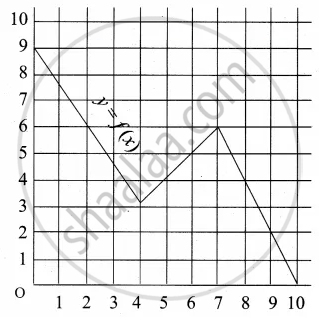Advertisements
Advertisements
Question
If f(x) = sin [π2] x + sin [−π]2 x, where [x] denotes the greatest integer less than or equal to x, then
Options
(a) f(π/2) = 1
(b) f(π) = 2
(c) f(π/4) = −1
(d) None of these
Solution
(a) f(π/2) = 1
f(x) = sin [π2] x + sin [−π2]x
\[\Rightarrow f(x) = \sin \left[ 9 . 8 \right]x + \sin \left[ - 9 . 8 \right]x\]
\[ \Rightarrow f(x) = \sin 9x - \sin 10x\]
\[f\left( \frac{\pi}{2} \right) = \sin 9 \times \frac{\pi}{2} - \sin 10 \times \frac{\pi}{2}\]
\[ \Rightarrow f\left( \frac{\pi}{2} \right) = 1 - 0 = 1\]
APPEARS IN
RELATED QUESTIONS
Let f : [0, ∞) → R and g : R → R be defined by \[f\left( x \right) = \sqrt{x}\] and g(x) = x. Find f + g, f − g, fg and \[\frac{f}{g}\] .
If f(x) = cos [π2]x + cos [−π2] x, where [x] denotes the greatest integer less than or equal to x, then write the value of f(π).
Let \[f\left( x \right) = \frac{\alpha x}{x + 1}, x \neq - 1\] . Then write the value of α satisfying f(f(x)) = x for all x ≠ −1.
Write the domain and range of function f(x) given by
Let f and g be two functions given by
f = {(2, 4), (5, 6), (8, −1), (10, −3)} and g = {(2, 5), (7, 1), (8, 4), (10, 13), (11, −5)}.
Find the domain of f + g
Let A = {1, 2, 3} and B = {2, 3, 4}. Then which of the following is a function from A to B?
If f(x) = cos (log x), then the value of f(x) f(y) −\[\frac{1}{2}\left\{ f\left( \frac{x}{y} \right) + f\left( xy \right) \right\}\] is
If \[f\left( x \right) = \log \left( \frac{1 + x}{1 - x} \right) \text{ and} g\left( x \right) = \frac{3x + x^3}{1 + 3 x^2}\] , then f(g(x)) is equal to
f is a real valued function given by \[f\left( x \right) = 27 x^3 + \frac{1}{x^3}\] and α, β are roots of \[3x + \frac{1}{x} = 12\] . Then,
The domain of the function \[f\left( x \right) = \sqrt{5 \left| x \right| - x^2 - 6}\] is
Check if the following relation is function:

If f(m) = m2 − 3m + 1, find f(0)
Find x, if g(x) = 0 where g(x) = x3 − 2x2 − 5x + 6
Check the injectivity and surjectivity of the following function.
f : N → N given by f(x) = x2
Express the following logarithmic equation in exponential form
`log_(1/2) (8)` = – 3
Find the domain of f(x) = log10 (x2 − 5x + 6)
Write the following expression as sum or difference of logarithm
`log (sqrt(x) root(3)(y))`
Prove that `"b"^(log_"b""a"` = a
Solve for x.
2 log10 x = `1 + log_10 (x + 11/10)`
Solve for x.
x + log10 (1 + 2x) = x log10 5 + log10 6
Answer the following:
Identify the following relation is the function? If it is a function determine its domain and range.
{(0, 0), (1, 1), (1, –1), (4, 2), (4, –2), (9, 3), (9, –3), (16, 4), (16, –4)}
Answer the following:
For any base show that log (1 + 2 + 3) = log 1 + log 2 + log 3
Answer the following:
If `log (("a" + "b")/2) = 1/2(log"a" + log"b")`, then show that a = b
Given the function f: x → x2 – 5x + 6, evaluate f(2a)
A graph representing the function f(x) is given in it is clear that f(9) = 2

What is the image of 6 under f?
Mapping f: R → R which is defined as f(x) = sin x, x ∈ R will be ______
Find the range of the following functions given by `|x - 4|/(x - 4)`
Find the range of the following functions given by `sqrt(16 - x^2)`
Let f and g be two functions given by f = {(2, 4), (5, 6), (8, – 1), (10, – 3)} g = {(2, 5), (7, 1), (8, 4), (10, 13), (11, – 5)} then. Domain of f + g is ______.
Find the domain of the following functions given by f(x) = `1/sqrt(1 - cos x)`
Let f(x) = `sqrt(x)` and g(x) = x be two functions defined in the domain R+ ∪ {0}. Find (f + g)(x)
The domain and range of the function f given by f(x) = 2 – |x – 5| is ______.
The range of the function y = `1/(2 - sin3x)` is ______.
If f(x) = x3 – 1 and domain of f = {0, 1, 2, 3}, then domain of f–1 is ______.
The expression \[\begin{array}{cc}\log_p\log_p\sqrt[p]{\sqrt[p]{\sqrt[p]{\text{...........}\sqrt[p]{p}}}}\\
\phantom{...........}\ce{\underset{n radical signs}{\underline{\uparrow\phantom{........}\uparrow}}}
\end{array}\]where p ≥ 2, p ∈ N; ∈ N when simplified is ______.
Which of the following functions is NOT one-one?
Let f be a function with domain [–3, 5] and let g(x) = | 3x + 4 |. Then, the domain of (fog) (x) is ______.
The domain of f(x) = `sin^-1 [log_2(x/2)]` is ______.
